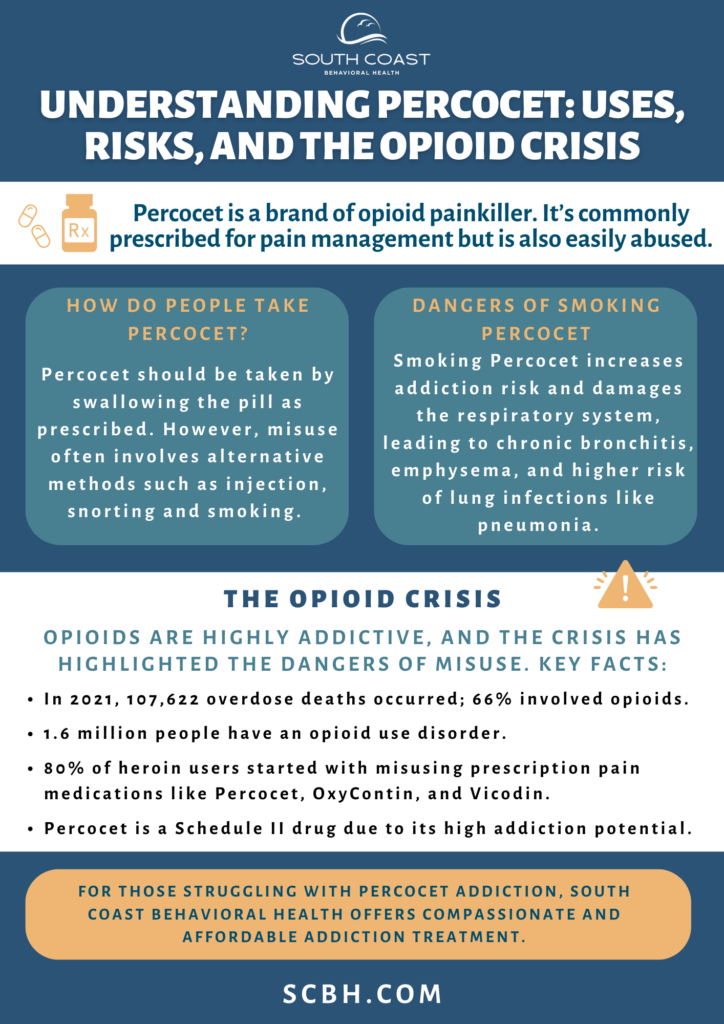Smoking pills like Percocet or Tylenol is a dangerous trend often fueled by misinformation and desperation. While some believe it might produce a faster or stronger effect, the reality is far more harmful. This article explores what happens when you smoke Percocet or Tylenol — and why it’s never safe.
What Is Percocet?
Percocet is a brand of opioid painkiller. It’s commonly prescribed for pain management but is also easily abused.
Percocet is a combination of two separate medications:
- Oxycodone: This is an opioid pain reliever, which works by affecting the way the brain perceives and responds to pain. It’s most commonly found in the drug Oxycontin.
- Acetaminophen: This is an over-the-counter pain reliever (found in products like Tylenol) that helps to increase the pain-relieving effects of oxycodone.
As mentioned before, Percocet is part of the opioid class of medicines. Opioids are a class of drugs that include the illegal drug heroin, synthetic opioids such as fentanyl, and pain relievers available legally by prescription, such as oxycodone (OxyContin®), hydrocodone (Vicodin®), codeine, morphine, and others.
Opioids are highly addictive. The opioid crisis, particularly in the United States, has brought significant attention to the dangers of misuse and addiction associated with these substances.
Here are some facts regarding the opioid epidemic:
- According to the Department of Justice, 107,622 people died from a drug overdose in 2021. Of that figure, 66% of the deaths were attributable to opioids.
- Per numbers from the US Department of Health and Human Services, 1.6 million people suffer from an opioid use disorder.
- Four out of five people who use heroin began by misusing prescription pain medications. Percocet, OxyContin, and Vicodin are a few commonly prescribed pain medications.
Like other opioids, Percocet carries such a high addiction potential. For this reason, the DEA classifies it as a Schedule II drug.
Can You Smoke Oxycodone Pills?
While snorting oxycodone is a popular method of abuse, some people also attempt to smoke Oxycontin or oxycodone in an effort to feel its effects more quickly, smoking it is extremely dangerous and not recommended under any circumstance.
Oxycodone tablets are designed to be taken orally and contain binders and fillers that release toxic fumes when burned. Smoking oxycodone also increases the risk of overdose, since the drug enters the bloodstream rapidly and unpredictably through the lungs. Oxycodone smoking is a sign of substance misuse and can lead to serious health consequences — including addiction, respiratory damage, and death. Finally, as a very popular street drug, many oxycodone pills are counterfeit (especially the m30 pills) — an additional risk of oxycodone smoking.
What Does Percocet Do?
Percocet is a prescription pain medication that is a combination of two active ingredients: oxycodone, which is an opioid (narcotic) pain reliever, and acetaminophen, which is a non-opioid pain reliever.
Oxycodone acts on the opioid receptors in the brain, blocking the transmission of pain signals. Acetaminophen, the active ingredient in Tylenol, is used to increase the pain-relieving effects of oxycodone.
Oxycodone also stimulates the release of dopamine, which can create a feeling of euphoria, leading to its potential for abuse.
Percocet can also have various effects on the body. The oxycodone within Percocet depresses the respiratory center in the brain, leading to slowed or shallow breathing. In high doses, this can be life-threatening. The drug can also impact the liver, since acetaminophen is metabolized there and can cause liver damage if taken in large quantities or over an extended period.
It can also affect the gastrointestinal system, causing constipation by slowing down the movement of the intestines and potentially leading to nausea and vomiting. Some who use it may also experience changes in the cardiovascular system, such as alterations in heart rate and blood pressure, though these effects tend to be less common.
Percocet Side Effects
Here are some of the side effects of Percocet:
- Dizziness
- Drowsiness
- Constipation
- Nausea
- Vomiting
- Mild itching
More serious side effects can include the following:
- Shallow breathing
- Slow heartbeat
- Confusion
- Seizures
- Liver problems such as jaundice
Finally, there’s the risk of addiction and dependence.
Percocet has a high potential for abuse and addiction, particularly if not used according to a doctor’s prescription. This can lead to physical dependence, withdrawal symptoms, and a compulsive need to continue using the drug.
Some people combine Percocet with alcohol or other central nervous system depressants to intensify their high. This is known as polysubstance abuse and, in the case of Percocet, can raise your risk of severe respiratory depression or even death.
The use of Percocet should always be under the supervision of a healthcare provider, and it should only be taken according to the prescribed dosage to minimize risks. Misuse or abuse can lead to serious health consequences, including addiction and death.

Get confidential help from our addiction treatment specialists in Orange County. Call to join our rehab program today!
Call 866-881-1184How Do People Take Percocet? Can You Smoke Percocet?
The intended way to take Percocet is by swallowing the pill, as prescribed by a medical professional. However, there are other ways that people might use this drug, especially when misused or abused.
However, there are three popular ways of abusing Percocet:
Injecting Percocet
Some individuals may choose to inject Percocet, which is an extremely risky and harmful method of administration. Injecting requires the pill to be crushed and mixed with a liquid to create a solution, which is then injected into the veins. This method is highly dangerous as it can lead to infections, vein damage, and other serious health issues.
Snorting Percocet
Snorting Percocet involves crushing the pill into a fine powder and then inhaling it through the nose. This method can cause immediate and intense effects, but it also presents serious risks, including damage to the nasal passages and respiratory system.
Smoking Percocet
Smoking Percocet is another unconventional and hazardous way to consume the drug, referred to on the street as “smoking percs.”. The pill is crushed into a powder and then smoked, usually by placing it on foil and heating it. Smoking Percocet can lead to lung damage and other respiratory problems.
The Dangers of Smoking Percocet
Smoking Percocet increases your risk of negative health outcomes as compared to other methods. For one, smoking Percocet leads to a much more rapid onset of euphoria, which makes it more addictive.
The damage to the respiratory system due to smoking Percocet is another issue. When Percocet tablets are smoked, the fillers and binders contained within the pills are inhaled into the lungs. These substances are not meant to be inhaled and can lead to chronic bronchitis, emphysema, or other serious respiratory issues.
Additionally, the risk of lung infections like pneumonia may increase with smoking Percocet. The inhalation of these foreign substances can cause persistent irritation and damage to the delicate tissues within the respiratory system, leading to long-term health problems that may be irreversible.
Can You Smoke Tylenol?
While it is physically possible to crush and smoke a Tylenol tablet, it would be pointless to do so because you wouldn’t get high. Tylenol contains acetaminophen, a non-opioid pain reliever. Because it’s not an opioid, there aren’t any opioid effects, like euphoria. In fact, all you would get from smoking acetaminophen would be extremely unpleasant and toxic fumes that may damage the lungs and other organs.
Again, unlike opioids or other drugs of abuse, Tylenol has no recreational effect when smoked. People who attempt this are often misinformed about its effects or may be struggling with substance abuse.
What Happens if You Smoke Tylenol?
When Tylenol is burned and inhaled, it can produce toxic fumes that damage the lungs, throat, and sinuses. Acetaminophen is not psychoactive, so smoking it won’t get you high — but it can cause serious health risks, including:
Lung irritation or chemical pneumonitis
Severe liver damage (especially when combined with other substances)
Increased risk of overdose, since smoking may lead people to use higher doses trying to feel an effect
Smoking Tylenol provides no benefit, recreational or otherwise, and carries significant health risks. If someone is misusing medications in this way, it may be a sign they need help from a drug and alcohol rehab in California.
Looking for quality substance abuse treatment that’s also affordable? South Coast accepts most major insurance providers. Get a free insurance benefits check now.
Check Your CoveragePercocet Addiction Treatment at South Coast Behavioral Health
The battle against opioid addiction is often a complex and arduous journey. Attempting to overcome addiction without professional help can be daunting and, in some cases, dangerous.
For those struggling with Percocet addiction, South Coast Behavioral Health offers compassionate and affordable addiction treatment.
The first step is going through a medical detox. Our medical detox program in California is staffed by caring and compassionate professionals who can provide you with medications to manage your withdrawal symptoms.
At South Coast, we take pride in offering care that is closely tailored to specific issues. To that end, we offer gender-specific detox programs, with medical detox for men in Irvine, CA, and medical detox for women in Huntington Beach, CA.
After detoxing, proper treatment can begin.
Treatment for substance abuse takes place along an entire spectrum of care. Along that entire spectrum are various behavioral therapies, support groups, and the use of medically-assisted treatment (MAT).
These levels of treatment are, in order, as follows:
Residential Treatment in California
After successfully completing medical detox, you’ll move to inpatient treatment in Orange County California. There, you’ll receive medically-assisted treatment and dual diagnosis treatment to deal with any cravings or co-occurring mental health issues you may be battling. We also offer residential treatment facilities in Costa Mesa, Irvine, and Huntington Beach for those who desire gender-specific treatment. There, patients get round-the-clock medical attention and monitoring while living at the institution full-time.
In addition to individual and group counseling and medication management, you’ll also have access to leisure activities and family support services.
Partial Hospitalization in California
Most clients start substance abuse treatment with South Coast in our residential treatment program. After completing that, many desire something that still provides structure and support, but with extra space and time to oneself. For that, we offer Partial Hospitalization in Newport Beach.
A step down from inpatient care but with more structure than conventional outpatient programs, partial hospitalization offers a good balance for those looking to ease back into normal life. Clients can receive care five to seven days a week for a number of hours each day, returning back to their homes in the evening.
This way, they can recover without putting their daily lives completely on hold, receiving intense therapeutic interventions like group and individual therapy, skill development, and medication management as necessary.
Intensive Outpatient Treatment in California
For those leaving inpatient residential treatment or partial hospitalization, intensive outpatient programs (IOP) are yet another gradual step forward on the road to recovery.
With a focus on group therapy, individual counseling, and education, clients undergoing Intensive Outpatient Treatment in Newport Beach can meet three to five days a week. Each session lasts three hours.
This level of care requires the least amount of attendance at a facility.
Get Started Today
If you or a loved one are struggling with substance addiction but wonder how long addiction counseling takes or have other questions, call us at 866-881-1184. Our highly qualified staff will be happy to help give you an idea of what to expect from your addiction recovery timeline, help verify your insurance, and assist with any other questions you may have.










